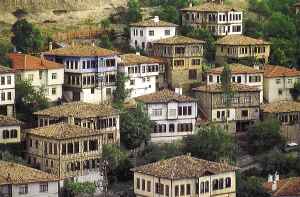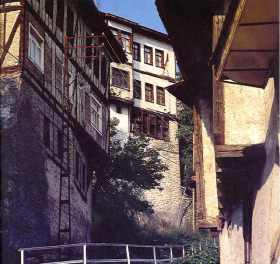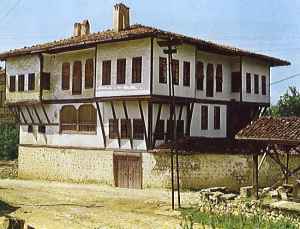SAFRANBOLU IN THE DEPTH OF LIFE
(Views of Safranbolu)
Whenever I decide to write an article about Safranbolu, which occupies
such an important place in my life, something always seems to be missing. Even if I have
decided on the title and the points which need to be emphasised, when it comes to setting
it all down in writing I feel that I haven’t managed to achieve quite what I wanted. I
began to understand the reasons for this in the course of time.
 Back in the 1950’s, when my relations with Safranbolu began, the richness
of the subtleties I had yearned for added new dimensions to my life for many years. The
unseen heritage of Anatolia gradually began to manifest itself in Safranbolu. Then I saw
more clearly what the integrity that depended on variety, that is, what Anatolia’s
cultural identity meant. Perhaps that was a why I experienced an inability to convey
satisfactorily much of this great fact in each of my articles. Perhaps the difficulty I
have experienced in adequately recording to various stages of the research I have been
engaged in for the past forty years have prevented me from setting down coherently the
methods devised to protect our cultural heritage and the results obtained. And not least,
frequently my attempts to make sure that all this data was evaluated in an unbiased
manner, and to have the results analysed properly have led to postponements. Back in the 1950’s, when my relations with Safranbolu began, the richness
of the subtleties I had yearned for added new dimensions to my life for many years. The
unseen heritage of Anatolia gradually began to manifest itself in Safranbolu. Then I saw
more clearly what the integrity that depended on variety, that is, what Anatolia’s
cultural identity meant. Perhaps that was a why I experienced an inability to convey
satisfactorily much of this great fact in each of my articles. Perhaps the difficulty I
have experienced in adequately recording to various stages of the research I have been
engaged in for the past forty years have prevented me from setting down coherently the
methods devised to protect our cultural heritage and the results obtained. And not least,
frequently my attempts to make sure that all this data was evaluated in an unbiased
manner, and to have the results analysed properly have led to postponements.
 As a result of a lifetime’s research into Anatolia, I have
often been forced to put the preparation of other publications before my own books, which
I am convinced provide a great deal of vital missing information on the subject. Thus the
publication of my own books has been constantly postponed. However, Safranbolu, which
needs to be written about stage by stage, each of which is documented, has not been
discussed in the detail which I feel necessary and its postponement has always been a
source anxiety to me. I believed that I would not forget anything while I was experiencing
Safranbolu, working on it and sharing it with others. However, things that have not been
recorded in note form have been forgotten and thus there are a number unclarified areas in
this great story. As a result of a lifetime’s research into Anatolia, I have
often been forced to put the preparation of other publications before my own books, which
I am convinced provide a great deal of vital missing information on the subject. Thus the
publication of my own books has been constantly postponed. However, Safranbolu, which
needs to be written about stage by stage, each of which is documented, has not been
discussed in the detail which I feel necessary and its postponement has always been a
source anxiety to me. I believed that I would not forget anything while I was experiencing
Safranbolu, working on it and sharing it with others. However, things that have not been
recorded in note form have been forgotten and thus there are a number unclarified areas in
this great story.
When I ask myself why I worry about it so much anxiety increases and the
absence of these interesting facts makes it clear that there are a number of blanks in the
story of my struggle to protect Turkey’s cultural heritage. It could be said that the
short story of the struggle to protect our cities is filled with the labours of people
from Safranbolu and from various walks of life. On the other hand, in the very first years
that Safranbolu became part of my life I collected all my sources and evaluated them in a
way that would show the relationship between the people of Safranbolu and their city. I
had embarked on a method of determination that could be used in a number of different
ways. Thus the features of urban development in Safranbolu, the traditional residential
pattern and the wealth of information collected from a number of fields could be collated
in a manner that was meaningful. If it is borne in mind that this activity extends over a
period of forty years, the changes brought about by time become clearer.
However, leaving these complaints on one side, what impressed me most was
the fact that this represented forty years of history, for if starting points in the form
of actual projects are sought in the attempts being made to protect Turkey’s cultural
identity and cultural heritage, to evaluate them in an appropriate manner, then Safranbolu
continues to be a symbol of these efforts. I am thinking about the posters I had prepared
in 1975 and in the years that followed. When titles such as "Safranbolu, the city
that protects itself" are brought together, the symbolic nature of Safranbolu becomes
even clearer.
 As concepts and methods of protection all over the world
changed, the laws of our country were amended or new laws enacted. However, it has not
been possible to make a survey of the cases in which these laws have applied. In survey of
these terms Safranbolu was the first place where words, faith, knowledge and organisation
became action. It was the first place because new methods appropriate to conditions in our
country were being tried and new solutions were being sought. Moreover, the political
situation was becoming more and more complex, its problems more and more insoluble.
Paradoxically, in spite of social unrest, progress was being made in this field. As concepts and methods of protection all over the world
changed, the laws of our country were amended or new laws enacted. However, it has not
been possible to make a survey of the cases in which these laws have applied. In survey of
these terms Safranbolu was the first place where words, faith, knowledge and organisation
became action. It was the first place because new methods appropriate to conditions in our
country were being tried and new solutions were being sought. Moreover, the political
situation was becoming more and more complex, its problems more and more insoluble.
Paradoxically, in spite of social unrest, progress was being made in this field.
An interesting point which deserves closer attention is that many natives
of Safranbolu who saw Safranbolu as part and parcel of this century had developed their
own, much more reliable methods of warning and enlightening others, which is why the
smallest detail of this period of my life, the slightest
Memory are all things that should have been written down and not
forgotten. However, the fatigue encountered in setting all this town on paper has resulted
in a number of deficiencies. Not one of the innumerable articles I have written or
research projects I have supervised can clearly express the dimensions of the difficulties
encountered, or how those who now seek prominence by issuing decrees for Safranbolu
ignored our efforts in the past. The history of persons, societies and of the world must
be written correctly. If "Safranbolu" is an integrity, then the rights and the
wrongs, success and failures, the dead and the living, as it were, must all be accounted
for in this special history.
Even the documentary films devoted to Safranbolu may bring out of much of
what we have managed to establish in the course of time. However, the story of the people
who created them remains obscure. Perhaps the feature which needs to be emphasised even
more than Safranbolu being the very first city to be included in its entire in the scope
of protection order is patience displayed by its people on this long and difficult road as
they hopefully awaited the emergence of the truth in the future. And when a stillness
finally descends after vain attempts to frustrate our efforts or to take credit where none
was really due, it was by no means easy to remember all the facts that needed to be
recorded.
I saw all this in the course of the work we were doing to get Safranbolu
included in the "World Heritage" list. While we were breathlessly trying to
consolidate our positions, a number of factors we had ignored suddenly achieved
importance. While some of us were putting up a spirited fight others, unable or unwilling
to face all the difficulties and persons who were using the time for their own purposes
suddenly became the guardian angels of Safranbolu. I have no ulterior motive in saying
this. The efforts made by principled, self-sacrificing, cultured persons to translate
their thoughts into action and the actions of those who sought the path of least
resistance both exemplify the long struggle to preserve our country’s crowning glory
during our lives in Safranbolu.
 However, when all this ignored there is honourable
resistance, measures which force people of faith to take a firm stand and display
solidarity. In consequence, Safranbolu has become the symbol of a city that could be
preserved in its entirety. Moreover this mass participation led to the success of actions
which embrace such topical concepts as democratisation and civil organisations, and have
served as an example for other cities. However, when all this ignored there is honourable
resistance, measures which force people of faith to take a firm stand and display
solidarity. In consequence, Safranbolu has become the symbol of a city that could be
preserved in its entirety. Moreover this mass participation led to the success of actions
which embrace such topical concepts as democratisation and civil organisations, and have
served as an example for other cities.
People who want our country to have a hopeful future have demonstrated the
strength of neighbourly relations in Safranbolu. They have proved that linking the past to
the present and the present to the future, strengthening the truths of the past and
transferring them to the future will inevitably result in cultural continuity. Safranbolu
has not served as an example to those who wish to see the difficulties of making right
triumph over wrong.
A down-to-earth solidarity was displayed by all the scientists, artists,
political and cultural figures involved in the Safranbolu, project. They gave their
support to local authorities and managed to make their voices heard in the international
arena. In creating a future based on these truths, the world wants many more cities like
Safranbolu, it wants to increase the strength of coming together in the cause of truth.
The existence of such cities serves to strengthen the bonds between generations and endows
art culture with different dimensions. The difficulty of connecting oneself with
Safranbolu and a few other cities like it in Anatolia, where the paths of different
cultures meet and where civilisations have developed has become more easily understandable
in a world heading towards globalisation and searching for a new identity. To put it in a
nutshell, there are lessons to be learnt from Safranbolu, new methods to be developed,
factors that will enrich our social structure and subtleties that need to be stressed by
artists. "What happened to forty years of unceasing effort?" I ask myself, and
the answer is "When you go to Safranbolu today it’s still there." Which tells
the faint-hearted that a difficult situation requires a strong personality to deal with
it.
Hoping that the example of Safranbolu will develop and spread to other
parts of the country.
- Source:
- By Metin Sözen
Turkey - From One End To The Other - P. 162ff.
Maestro Publications
Views of Safranbolu
|